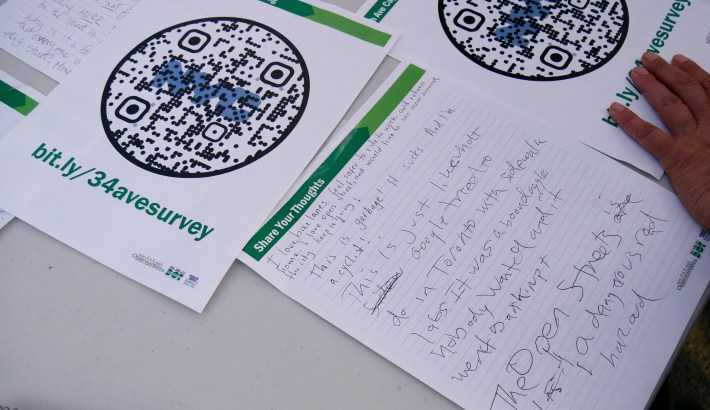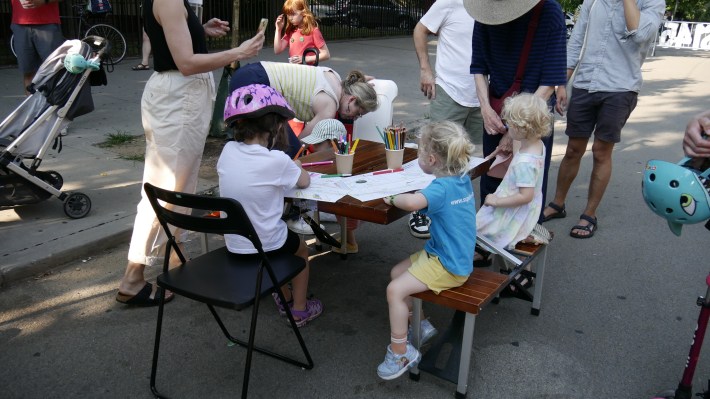What will become of the city's "gold-standard open street"?
Supporters of Paseo Park, the Jackson Heights open street that city officials have long championed with that superlative, have hired their own architecture firm in hopes of making permanent and improving the current design as the Department of Transportation opened its formal outreach program for the proposed $89-million capital construction project to play out over the next year.
Not willing to risk that the neighborhood's small, but hearty, band of park opponents get the ear of DOT during the planning of the 26-block stretch between the Brooklyn-Queens Expressway and Junction Boulevard, the community group that is coordinating the long-term vision for the open street has hired architecture firm WXY to help with the planning via outreach.
The Alliance claims it will work in step with the DOT on the design for the park, but will likely push the city further — which was symbolized by the fact that the Alliance had its own tent right next to the tent where DOT officials solicited neighborhood feedback for the first time last Tuesday.

“The opportunity here is really thinking about the future of the open street program,” Rob Daurio, a senior associate at WXY, told Streetsblog.
Luz Maria Mercado, the chair of the board for Alliance for Paseo Park, emphasized that the goal is "robust community engagement."
"We know our future Paseo Park will be better if we are able to reach different segments of our community through robust and culturally competent outreach that allows for in-depth and ongoing conversations," she said in a statement. "We are coordinating with the DOT and sharing our learnings with their team. We have hired WXY to assist with the outreach and engagement process."
DOT looks forward to it.
"We’ve transformed 1.3 miles of a typical city street into a community hub where residents, families, and school children can safely commute, gather and play with one another, and enjoy diverse programming," agency spokesperson Anna Correa said. "We look forward to developing a capital project with permanent materials that builds on the success of our design while also addressing feedback from the community on how we can make it even better.”
The agency added that it has received "strong interest" in a slow corridor for social cycling, programming, and walking that builds on the "current successes."
The outreach begins
DOT representatives fielded questions and heard criticisms from a small group of community members that claims the linear park has destroyed their community (countering sweet anecdotes from several children about how much they enjoy getting to play outside more).
Several residents set up signs, and one resident even taped her mouth shut, saying it symbolized how she was being silenced by the DOT, although she did fill out a feedback worksheet and talked with the department representatives — just as opponents of Paseo Park have done for four years.
Few of the opponents stopped to remember 34th Avenue's previous life as a car-choked thoroughfare where crashes and injuries were common. There were 41 reported crashes on the stretch in the first five months of 2019, before the car-free open street was created. In the same period this year, there have only been 12 total crashes, a decline of 70 percent.
The feedback was far from scientific: for every community member writing some version of, “I love open streets, I feel safer to ride to work,” there was another writing, “This is garbage, it sucks.”

Possible plans
At a “moped town hall” last month, the DOT did hear specific complaints about pedestrians sharing space with mopeds — which are illegal in Paseo Park, but are frequently used by delivery workers who feel unsafe on the neighborhood's chaotic parallel avenues.

There are two options for the capital reconstruction: one would create a two-way bike lane instead of one lane on each side of the median mimicking the original flow of car traffic:

The “shared blocks with plazas” option would keep the bike lanes together through the center of the street, next to the existing median, and alternate one way streets for cars, which the DOT says reduces vehicles on the corridor but allows local block access.
Meanwhile, the “plaza blocks with traffic calming” design utilizes a two-way bike line, but it would be curbside on so-called "plaza" blocks (where no cars are allowed at all).

Opinions varied greatly on how bikes and pedestrians should share a linear park.
Jim Burke, the co-founder of the 34th Avenue Open Streets Coalition, and a huge supporter of the open street, worried that a dedicated bike lane only makes cyclists go faster than the current 5 mile-per-hour speed limit.
“If I want to go fast I go to another street,” he said.
But some residents with young children complained that cyclists would be all over the roadway without their own space separate from other activities such as strolling or even learning how to ride ... a bike.
“[The open street] is the first place I’ve ridden a bike in New York City,” said Rita Wade, 60, a 25-year Jackson Heights resident. “As someone who is older and who is a cautious biker, this is a great way to get around my own neighborhood.”
Others, of course, simply tried to convince the DOT that the park shouldn’t exist at all and that the $89 million should be spent elsewhere. Several people refused to even contribute ideas to a new design, some of whom will likely complain about the resulting plan as not reflecting their opinion.
Community tension
Members of the community who object to Paseo Park raised arguments they have made since its inception: namely that life in the neighborhood was better when the strip was riven by constant car traffic.

To such residents, city life itself — friends hanging out, people walking and talking, others enjoying community events such as Zumba classes or English-language lessons — is a “nightmare.”
“End this nightmare at once,” one resident wrote on the feedback form. “Re-open the street to cars.”
Reopening the street to cars would have the opposite effect on community well-being. Safety hasn’t just improved on Paseo Park itself, but according to city statistics, in the square-mile area bounded by 32nd and 37th avenues, Junction Boulevard and the BQE, there were 4,228 reported crashes in the four years before the creation of the open street, according to city stats. In the four years since the open street was created, there have been, 2,485 reported crashes according to the same stats.
That's a "nightmarish" drop of 41 percent across an entire neighborhood.

The equally strong-in-numbers group of park evangelists discussed the profoundly positive impact the park has had on the community, specifically those who did not have access to green space prior to Paseo Park.
“I grew up without green space,” added Mercado, a lifelong Jackson Heights resident. “When I was a kid, I would walk around the neighborhood and look through gates to private gardens. Now, I think of children like me, low-income children, that are now able to have the space that I didn't have.”
A third group of people at the event represented the in-betweeners: people who say they support adding more green space to the neighborhood and claim that their minor criticisms of Paseo Park are met with backlash. But at the same time their criticism usually ends with calling for the park to be eliminated.
“DOT thinks everyone with concerns is against green space,” said Kaja Whitehouse, a mom who lives on 34th Avenue and finds Paseo Park disruptive to what she claimed was a quiet residential community before cars were banished. She cited teenagers hanging out at night and live music, though such things are a matter of enforcement, not design.
“I don’t want to live in a park,” said Whitehouse.
Clarification: An earlier version of this story suggested that WXY is drawing up an independent plan. For now, it is not. It is merely helping with the outreach.






